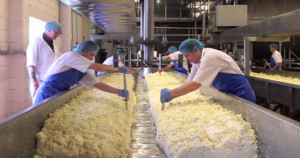Paneer Manufacturing
“Prepared by heat and acid coagulation of milk, Paneer is marble white in appearance, having firm, cohesive and spongy body with a close nut and a sweetish-acidic-nutty flavor.”
Cottage cheese, popularly known as Paneer, is a non-fermentative, non-renneted, non-melting and unripened type of cheese. In India, the paneer is currently marketed by many brands such as Amul, Britannia, Mother Dairy, etc.
Why Paneer?
- It is a rich source of animal protein available at a comparatively lower cost.
- Due to its high nutritive value, paneer is considered an ideal food for the expectant mothers, infants, growing children, adolescents and adults
- The ever growing demand of paneer by varied health conscious consumers has lead to researchers to develop new types and varieties of paneer. Few of the examples include skim milk paneer, fiber enriched low-fat paneer, low-fat paneer enriched with whey protein concentrate, paneer pickles, fruit paneer, etc.
Preparation of paneer using different types of milk and varied techniques results in wide variation in physio-chemical, microbiological and sensory quality of the product.

“Paneer keeps well for about a day at ambient temperature and for about a week under refrigeration (7 °C). The spoilage of paneer is mainly due to bacterial action.”
Making Paneer
Paneer manufacturing involves the coagulation of milk proteins to form curd. During this process large clumps of proteins are formed in which fat and other colloidal and dissolved solids get entrapped. The coagulation of milk occurs when pH of milk reaches 4.6 which is the isoelectric point of its major protein, casein. The type and concentration of the acid and the mode of delivery into the hot milk influence the moisture level and product yield.
“Heat treatment of milk causes destruction of microorganisms, denaturates whey proteins and retards colloidal calcium phosphate solubility. Acidification precipitates casein micelles along with denatured whey proteins and insoluble calcium phosphate.”
3 membrane processes involved in Paneer Manufacturing are:
1. Ultrafiltration
2. Microfiltration
3. Reverse Osmosis

Membrane Processes involved in Paneer manufacturing
- Ultrafiltration: In a study published by Kanawjia and Singh in 2000, it was reported that the concentration of standardized milk (2% fat, 9.2% SNF) to 27% TS through use of ultrafiltration for the manufacture of paneer resulted in a greater proportion of whey proteins bound to the casein network than the paneer made from unconcentrated milk, giving 95.0% TS recovery on the basis of ultrafiltrate. It led to increase in the yield of paneer by 25%.
- Microfiltration: Microfiltration (MF) technology has been employed for selective fractionation and concentration of standardized cow milk. According to a paper published by Kanawjia and Rizwi in 2000, the micro filtered retentate can be utilized for the manufacture of paneer, provided calcium chloride was added to the retentate at a level of 0.15%. Such additive helped in improving the organoleptic and textural properties of resultant paneer.
- Reverse Osmosis: Gupta and Pal (1995) observed that paneer made from milk concentrated by reverse osmosis to 1.5x (25% TS) and 2x (33% TS) resulted in higher yield by 2–3% on original milk amount basis compared to control without affecting its sensory properties.
The use of these modern technological processes can help the organized dairies in enhancing shelf life, facilitating distribution and marketing of product, increasing profitability and improving the export performance of paneer.

